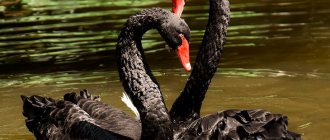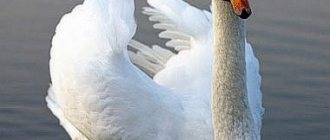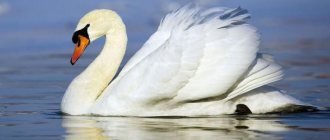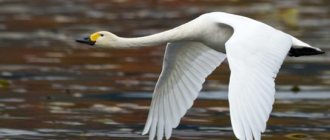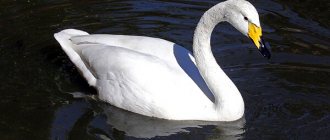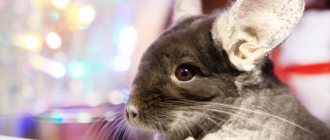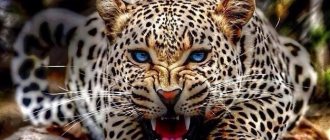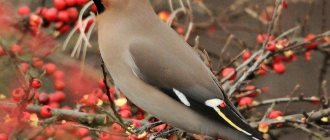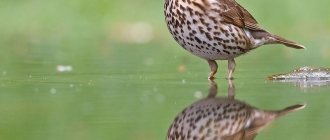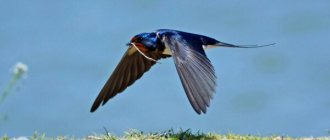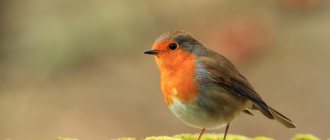Swans are beautiful waterfowl, the largest of all existing on earth at present. What types of swans exist and why each of them is interesting, we will tell you in our review.
There are currently seven species of swans: black, American, whooper, mute, black-necked, little and trumpeter. Males and females of the same species are almost the same size, so the untrained eye can hardly tell them apart. An interesting feature of all species is that swans almost always form monogamous pairs. The partners raise the cubs together, guarding them until the age of two years.
Black (Cygnus atratus)
Inhabits the entire southwestern part of the Australian continent, New Zealand and North America (mainly in nature reserves). The bird nests in swamps and river mouths, and also lives in captivity in zoos around the world. Despite its beauty and limited habitat, the black swan is not listed in the Red Book. Females are slightly smaller than males; both representatives of the species have black plumage and a red beak. Adults reach a weight of 9 kg and a length of up to 142 cm. In the wild, this species lives up to 10 years.
Description of the swan and habitat
This is a very large bird. Its size varies depending on the type. The length of an adult individual reaches 110-180 cm, weight - 11-16 kg.
The neck is often larger than the length of the body. The wingspan is amazing - it is 2 m. The legs are short. Birds have three types of plumage: gray, white and black. Females and males are colored the same. The life of swans is spent mostly on the water. On the ground, birds move slowly, waddling. Birds fly excellently thanks to their well-developed muscles. The diet of these waterfowl consists of animal and plant foods. The main diet is:
- roots of underwater plants and algae;
- small crustaceans, larvae and mollusks;
- small fish and tadpoles;
- cereal seeds, grass, tree leaves and berries.
The expanses of lakes and ponds, river floodplains are the places where the swan lives.
Birds almost always nest in dense thickets and love ponds with standing water rich in vegetation. In the south, flocks settle in closed sea bays, tropical swamps, wet prairies and forests. The distribution area of the northern subspecies is tundra and forest-tundra forests, rich in water sources. These representatives of the order Anatidae are very careful and do not nest near human habitation.
Almost all breeds of swans are migratory; during migration they are able to travel more than a thousand kilometers. Flocks return from wintering in early spring. In the southern part of the Northern Hemisphere, birds can be observed in mid-March; residents of the north return to their homeland in May.
Black-necked (Cygnus melanocoryphus)
The neck of a representative of this species is painted black, the rest of the body is snow-white, the beak is gray with a growth. The weight of an adult reaches 6.5 kg, length - up to 140 cm. The black-necked swan lives on small islands or in reeds, where it builds nests. In captivity, the life expectancy of individuals reaches 30 years, in the wild - up to 10. Males carefully guard the female while incubating eggs. Black-necked chicks are very active, often moving around while sitting on the back of their mother or father.
Species and man
In the old days, the bird was actively hunted - swan meat was considered a delicacy, and swan down was also highly valued. After the mute swan became extremely rare due to ruthless hunting and disturbance, it lost its commercial significance. Swans hunting was completely banned in the USSR in the 1960s. The mute swan is a peaceful and easily tamed bird, so it is often kept in enclosures or, with regular feeding, in open reservoirs in parks. In many areas of Europe, poultry are actively fed, and mute birds have become almost domesticated there. Proper feeding of grain can save swans from starvation during wintering. At the end of the 19th and beginning of the 20th century, due to famine and military action, the mute swan was completely exterminated in Belarus, but then recovered thanks to the resettlement of birds that survived in Poland and Lithuania. In Great Britain, mute swans are the property of the Queen, and the Queen of Great Britain owns more than 20,000 of these birds. In Denmark, the mute swan is one of the national symbols. Swans, like other waterfowl, suffer from sloppy human extraction of hydrocarbons, from oil and fuel oil leaks, and die painfully when landing on oil and fuel oil puddles during flights.
Mute swan (Cygnus olor)
One of the largest species, on a par with black. An adult representative of its species can gain weight up to 15 kg in park conditions and up to 13 in the wild. The wingspan is about 2.5 meters. The color is white, the head is ocher, the beak is red with a nail, the paws are black. The young have a brownish color, gradually giving way to white by the age of 3. You can recognize the mute fish by its dense neck in the shape of the Latin letter “s”.
Description
Most of the mute swan's body length is the neck
It is distinguished by an elongated body with a long neck. You can recognize the bird by its orange-red beak; there is a black growth at the base. It got its name due to the special sound it makes when irritated. May hiss, snort, wheeze and whistle. These sounds are usually directed at a predator or offender in order to scare him away. It belongs to the phylum Chordata, the class of birds and the order Anseriformes.
On average, the length of this creature is 180 cm. The weight of females is 5–6 kg, and that of males is 8–12 kg. The wings are very beautiful, their wings resemble sails.
Whooper swan (Cygnus cygnus)
A large bird with a weight reaching up to 12 kg. The wingspan is about 2.4 meters, the body is at least 155 cm long, the neck and body are approximately the same length. A distinctive feature is a lemon beak, black at the end. The color of the bird is white, however, young swans of this species are gray with a dark head. The neck is always kept straight, not bent like a mute dog. They form pairs for life, with the male often remaining alone for the rest of his life if the female dies, and vice versa. In captivity, the lifespan of the whooper reaches up to 30 years.
Range, habitats
Most species of swans live in temperate climates and only a few of them can live in the tropics. These birds live in Europe, some Asian countries, America and Australia. Swans do not live in tropical Asia, northern South America or Africa. On the territory of Russia they are found in tundra zones and, much less frequently, in forest zones. To the south, their range extends from the Kola Peninsula to the Crimea and from the Kamchatka Peninsula to Central Asia.
This is interesting! Some of the swan species have been declared national treasures. For example, whooper in Finland and mute in Denmark. The latter, in addition, in Great Britain are considered the personal property of the queen, and only members of the royal family are allowed to use the meat of these birds for food.
The favorite habitats of swans are large lakes, overgrown with reeds and other aquatic vegetation along the shores. Sometimes they can settle on the sea coast if there are reed beds nearby. If people treat these birds with respect and are not too annoying, they can settle in ponds near populated areas. With some exceptions, swans are migratory birds. But sometimes they can remain in their nesting areas. For example, whoopers sometimes spend the winter in the ice-free straits of the White and Baltic Seas.
Return to content
Trumpeter swan (Cygnus buccinator)
The trumpeter is similar in appearance to the whooper, but its beak is completely black. The plumage is white, body weight reaches 13 kg, and length up to 180 cm. At the end of spring, the breeding season begins for trumpeters, and the female sits on the nest for exactly a month. In total, during the incubation period, she is able to lay 9 eggs. In captivity, trumpeters live up to 30 years, in the wild - up to 10.
Reproduction
Swans are monogamous . They choose their partners for life.
Mating season
Birds reach sexual maturity at the age of four years.
With the arrival of spring, the mating season begins. The courtship ritual of these graceful birds is similar to a ballet dance. It takes place in water or on land. The male walks or swims in front of the female. At the same time, he screams loudly, raises his wings and feathers on his neck. If the heart of the swan (as the female swan is popularly called) is touched, she takes a similar pose. After this, the couple looks for a nesting site , which the head of the family courageously defends from the encroachment of his flock neighbors.
Nesting
In May, the swan builds a nest. She does this herself, without the participation of the male. The hen chooses secluded places near the water. The swan's nest is a structure with a diameter of 1.5-2 meters made of reeds, grass and the bird's own down. The clutch consists of 4-8 eggs, in young birds - 1-2. Interestingly, at first the eggs have an olive tint, and before the chicks hatch, they turn yellow-brown. Only the female sits on the nest; the male guards her, not moving away long distances. The incubation period lasts 35-40 days.
Raising chicks
Chicks weighing 200-220 grams are born covered with gray down. There is often a debate among bird lovers about the name of a baby swan. Ornithologists give the only correct answer - a chick. Babies are born well developed and immediately begin to accompany adults. Both parents take
care of the offspring A couple of days after hatching, the chick learns to swim under the supervision of its elders. At the age of two weeks, the cub already finds food on its own. Before molting, the chick is incapable of flight. Plumage change occurs at 4-5 months. Until this time, the young animals are kept in the family .
American (Cygnus columbianus)
The smallest representative of all species. Its dimensions do not exceed 146 cm in length, and its weight reaches 10 kg. It looks like a whooper, but its neck is shorter, its size is more modest, and its head has a rounded shape. The beak is yellow with an admixture of black. When the female incubates the nest, the male jealously protects her. American swans nest on the outskirts of reservoirs and in mossy areas of the tundra. Life expectancy in captivity is about 29 years.
Keeping swans at home
Swans get used to humans quite easily. It is enough for the birds to hint that there will be no shortage of food, and they will not fly away. Ideal maintenance is the presence of a reservoir or a large but shallow pond. True, you will have to constantly clean both the pond and the area around it from bird droppings.
In the home diet, protein foods include boiled eggs, minced meat and fish. Swans happily eat chopped raw and boiled vegetables, steamed cereals: rice, millet, wheat, corn. Domestic swans' food should be served with water. In winter, the diet must include dry feed and yeast (0.5% per 1 kg of mixture). Birds eat even at night. It is necessary to ensure that the food is fresh and the food containers are clean.
Small (Cygnus bewickii)
Externally it looks like a whooper, body length – 140 cm, wingspan – 200-210 cm, beak short, yellow-black. Feature: the pattern on the beak is individual for each individual of the same species. Endemic to Russia, in particular to Chukotka and the Kola Peninsula. Its characteristics are similar to the American tundra. Lifespan in captivity is up to 20 years. A rare bird, included in the Red Book of the Russian Federation.
What sounds do birds make?
Based on the nature of the sounds they make, birds are divided into three types:
- The whooper swan with its ringing loud cry. In nature, you can hear its cry during the mating season. The rest of the time, the birds are silent, only giving a sign of alarm when danger approaches. This bird is distinguished by its lemon-colored beak with a black tip.
- A trumpeter swan whose cry resembles the sound of a trumpet. The color of its beak is different from other bird species - it is completely black.
- The mute swan cannot scream, but can hiss threateningly at the enemy. The beak of these birds is red with a marigold.
Interesting Facts
- Birds have a bad temperament, they are timid and do not approach people well.
- They love to move on water, but are clumsy on land.
- In Britain, the capture of swans is prohibited by law, and all birds of these species are considered the property of the royal family.
- Sometimes black swans can create homosexual couples. After laying an egg, such a couple may even expel the female in order to incubate the egg in turns.
- The warmer the region where it lives, the darker the color of the bird.
- These birds are wonderful parents. They nurse their babies until they are 2 years old, helping them get their own food and taking care of them.
- An adult bird can attack a person and even break his bone.
General information
The swan (lat. Cygnus) is a waterfowl from the order Anseriformes and the Anatidae family. A common feature of all varieties of these birds is a long and dexterous neck , which allows them to get food in shallow water without diving. Swans can fly, love to move on water, but are clumsy on land. Adult male and female representatives of the same species are colored the same and have almost identical dimensions, so it is very difficult to distinguish them. The warmer the nesting area, the darker the color of the bird's feathers. As for character, these anseriformes are distinguished by their developed intelligence.
Thanks to its graceful body structure and noble appearance, the swan is considered a majestic and aesthetically attractive bird. It represents beauty, grace and grace. Almost all swan species are on the International Union for Conservation of Nature Red List .
Important! It is necessary to remember that swans have a timid disposition and do not approach people well. If you spot these birds in the park area, do not try to get too close to them. An adult bird, out of fear, can attack a person and even injure him, breaking his bones.
The bird is known for its rather long lifespan. Under natural conditions, these waterfowl can live 25–30 years.
Swans are very attached to territory. All species of swans are monogamous birds , forming permanent, inseparable pairs for life. Moreover, if the female dies, her partner remains alone for the rest of her life, and vice versa. But often after the death of a swan from a pair, the second (or second) soon also dies. Thanks to this devotion to their family, swans have become a symbol of fidelity and romance. Year after year, these birds can use the same nesting site, flying to the chosen place and correcting their “home.” Swans establish a nesting area near the water, where the female then incubates 3–7 eggs for 30–40 days. The male does not move far from the nest, guarding the female.
Swans are known as excellent parents; both partners take part in feeding and raising the brood. Anseriformes look after their young until the age of 1 or 2 years, helping them catch food and protecting them.
What do swans eat?
Under natural conditions, they prefer to feed in shallow water. The main food of these birds is:
- Aquatic vegetation (small algae, duckweed; stems, shoots and roots of aquatic plants). Plant foods contain many vitamins and minerals (especially iodine), which are beneficial for the plumage, skin and a number of internal organs of the bird.
- Coastal grass and foliage from willow thickets hanging over the water. The grass is rich in vitamin B9, folic acid and fiber, which promote the growth of poultry, increase the level of oxygen in the blood, and normalize the digestion process.
- Small fish. Fish contains essential amino acids, as well as polyunsaturated fats required for proper functioning of the heart and brain.
- Crustaceans. They have a beneficial effect on the condition of plumage. In addition, it is a very nutritious product.
- Amphibians (frogs). Frog mucus has a bactericidal (anti-inflammatory) effect. Amphibian meat contains a large amount of vitamins and minerals (in particular, a lot of calcium), which improve the functioning of the body. Calcium improves the condition of plumage, gives it shine, and prevents feathers from falling out.
- Mollusks and their external skeleton (shells). The benefits of this food are to improve metabolism and strengthen the body (immunity) as a whole. Shellfish are also beneficial due to the presence of large amounts of mineral salts and vitamins.
- Insects and their larvae. The benefits of this delicacy for swans are due to the high content of calcium, phosphorus, vitamins and low fat content. Insects in the swan's diet help protect the body from the harmful effects of an environmentally unfavorable environment.
Important ! It is important for city residents to remember that closer to winter it is not advisable to feed swans with bread. Brown bread is especially harmful for anseriformes, as it can cause severe fermentation processes in the gastrointestinal tract. White bread is not dangerous, but food that is too high in calories can dull the bird’s migratory instinct. It is better to use grains as food - oats, corn, but not hard grains, but lightly boiled ones. Swans also readily eat grated vegetables and hay soaked in water.
Birds filter bottom silt in search of food. Due to the special structure of the oral apparatus (the beak is equipped with plates inside and teeth along the edges), they circulate water. Water entering the beak brings with it food particles that remain in the mouth. Having caught a frog or fish, swans do not swallow the food immediately, but wait until the water flows out of their beak. The denticles also help these anseriformes easily bite off parts of plants. Different species of wild swans have their own individual characteristics of feeding behavior, which largely depend on the nesting site.
